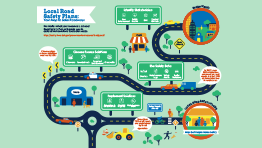
Proactive safety planning can change the landscape of road design and maintenance. Reactively adding safety countermeasures to crash sites is a viable strategy—but requires crashes happening in the first place.
As part of the virtual 2020 National Summit on Rural Road Safety, presenters from the Federal Highway Administration and National Center for Rural Road Safety (NCRRS) hosted a series of breakout sessions on "Strategies for Applying Rural Safety Countermeasures in a Proactive (Not Reactive) Way."
FoRRRwD
Dick Albin, safety engineer with the FHWA, gave a talk about the Focus on Reducing Rural Roadway Departures program (FoRRRwD), an initiative designed to provide transportation professionals with resources for reducing lane-departure crashes on rural roads.
"When we look at fatalities on the nation’s roads, over 35,000 people get killed in an average year," Albin said. “About half of those happen on a rural road. The majority of those are roadway departures.”
The objectives of FoRRRwD are, in order:
- To keep vehicles in their lane.
- To reduce the potential for crashes when drivers leave the roadway.
- To minimize the severity of crashes that do occur.
To achieve this, the program has four pillars that form the basis of its response strategy:
- Addressing all public roads, since almost half of rural roadway departures occur on roads not maintained by a state agency.
- Using a systemic approach to identify risk factors, since roadway departures are widespread and difficult to stay ahead of using only crash data.
- Creating safety action plans at all levels of government—federal, tribal, state, region, and local—to ensure the problem is uniformly addressed.
- Applying redundant safety countermeasures so that if one fails, another might take over.
“Really, what we’re trying to do is get there before the crash happens,” said Albin, “rather than waiting for the crash to happen.”
More information on the program can be found at the FoRRRwD website.
Low-cost countermeasures
To implement road safety countermeasures in a widespread and proactive manner, keeping costs down is an important factor. Nicole Oneyear, research engineer at the Iowa State University Institute for Transportation and representative for the NCRRS, focused her presentation on specific, relatively inexpensive improvements that traffic professionals can apply to their own local roads.
The presentation detailed low-cost safety strategies for dealing with unsignalized intersections, signalized intersections, pedestrians/bicyclists, and overall maintenance. Some notable countermeasures include:
- Placing an extra stop sign at an intersection—usually to the left of the road or on an island—so there’s an increased chance of being spotted.
- Advanced intersection warning—signs that give drivers a heads-up before they come to the actual intersection.
- Dilemma zone protection—stop lights that don’t change to yellow when they sense an oncoming car is too close to comfortably stop.
- Leading pedestrian intervals —walk signals at intersections that give pedestrians the chance to start crossing 3 to 7 seconds before vehicles get a green light.
- Bike boxes—painted, designated areas at the head of a traffic lane where cyclists can safely wait for intersection lights to change.
More information about countermeasures.
—Sophie Koch, LTAP freelancer